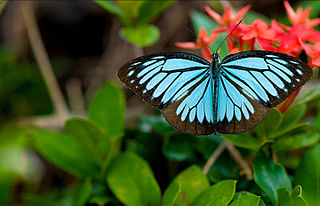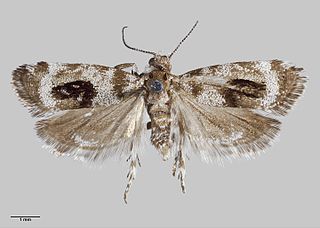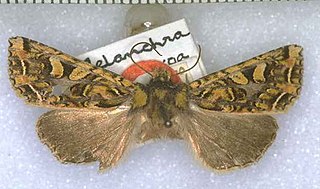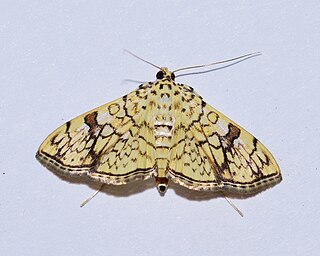
Pareronia valeria, the common wanderer or Malayan wanderer, is a medium-sized butterfly of the family Pieridae, that is, the yellows and whites, and is found in India and Southeast Asia. The butterfly found in India is sometimes considered as a separate species, Pareronia hippia.

Dodona ouida, the mixed Punch, is a small but striking butterfly found in the Indomalayan realm in West China, Himalayas, Northeast India (hills) and Burma that belongs to the Punches and Judies, that is, the family Riodinidae.

Junonia hierta, the yellow pansy, is a species of nymphalid butterfly found in the Palaeotropics. It is usually seen in open scrub and grassland habitats.
Oxygnostis is a genus of moth in the family Lecithoceridae. It contains the species Oxygnostis diacma, which is found in Sri Lanka.

Asterivora inspoliata is a species of moth in the family Choreutidae. It is endemic to New Zealand and has been found in the southern parts of the South Island. Adults are on the wing in December and January.
Anarsia semnopa is a moth of the family Gelechiidae. It was described by Edward Meyrick in 1921. It is found in Mozambique, South Africa and Zimbabwe.

Meterana tetrachroa is a species of moth of the family Noctuidae. This species is endemic to New Zealand. It is classified as "Data Deficient" by the Department of Conservation.

Pyrgotis eudorana is a species of moth of the family Tortricidae. It is endemic in New Zealand and has been observed in both the North and South Islands. However it is regarded as a rare insect. This species inhabits native forest. Larvae exclusively feed on Muehlenbeckia australis and adults are on the wing from November to April. Adults are attracted to light.

Haritalodes polycymalis is a species of moth in the family Crambidae. It was described by George Hampson in 1912. It is found in sub-Saharan Africa from Sierra Leone to South Africa.
Dichomeris ligyra is a species of moth in the family Gelechiidae. It was described by Edward Meyrick in 1913. It is found in Gauteng, South Africa.
Hypatima isotricha is a species of moth in the family Gelechiidae. It was described by Edward Meyrick in 1921. It is found on Java in Indonesia.
Telphusa smaragdopis is a moth of the family Gelechiidae. It is found in Costa Rica.
Leuronoma vinolenta is a moth of the family Gelechiidae. It was described by Edward Meyrick in 1919. It is found in southern India.
Cyanocrates inventrix is a moth in the family Xyloryctidae. It was described by Edward Meyrick in 1925. It is found in Nigeria.
Thymiatris arista is a moth in the family Xyloryctidae. It was described by Alexey Diakonoff in 1968. It is found on Luzon in the Philippines.
Petasanthes is a monotypic moth genus in the family Depressariidae. Its only species, Petasanthes leucactis, is found in Ecuador. Both the genus and species were first described by Edward Meyrick in 1925.
Antaeotricha plerotis is a species of moth in the family Depressariidae. It was described by Edward Meyrick in 1925. It is found in Peru.
Antaeotricha nerteropa is a moth in the family Depressariidae. It was described by Edward Meyrick in 1915. It is found in Peru.
Bursadella grammozona is a moth in the family Immidae. It was described by Edward Meyrick in 1925. It is found in New Guinea.

Ichneutica paraxysta is a moth of the family Noctuidae. It is endemic to New Zealand. This species is very similar in appearance to its close relative I. acontistis but as the range of the two species do not overlap this is unlikely to cause confusion. I. paraxysta is only found in the North Island at the subalpine zones in the Mount Taranaki region and at Mount Ruapehu. It prefers tussock grassland and shrubland habitat. The life history of this species is unknown as are the host species of its larvae however it has been hypothesised that the larval host plants are species in the genera of Poa and Festuca.







